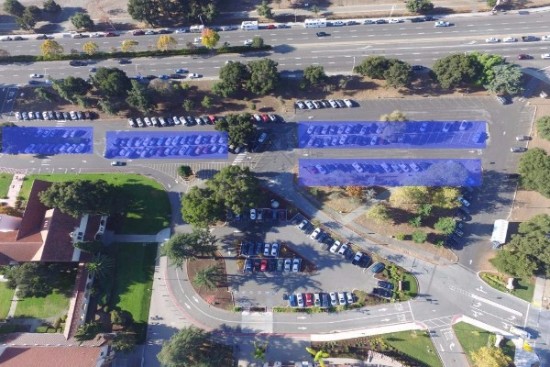
Palo Alto High School’s Embarcadero parking lot will contain solar parking panels by the 2018 school year to help offset Palo Alto High School’s electricity bill.
The construction will take place during the summer to make sure that campus life is unaffected, PAUSD energy education specialist Rebecca Navarro said.
“I think we’re going to do our best to have it [the construction] be during summer so that the impact is minimal in that regard,” Navarro said. “On top of that, from what I’ve seen of these projects, it’s a very neat and small kind of construction project. Once they get them [the panels] up on top of the supports it’s a pretty small project, it’s not too messy or noisy.”
Four panels will be built in the parking lot at the intersection of El Camino Real and Embarcadero Road, a report prepared by Renewable Energy Corporation Solar, the contractor building the solar panels, said.
According to the electricity rates provided by City of Palo Alto Utility Rate Schedule E-7 for large non-residential electric services, the district would be able to save almost $66,000 per year using these solar panels.
The original purpose of the solar panels was to alleviate some of Palo Alto High School’s electricity consumption, Navarro said.
According to Navarro, Palo Alto High School uses an average of 200,000 to 350,000 kilowatt-hours per month, or about 2400 to 3500 megawatt-hours per year.
“The intention was not to offset 100 percent of the demands for electricity at Paly, so much as to just offset a reasonable portion of it that would make us a little more comfortable in such things as rate increases, and square footage increases, and things like that,” Navarro said. “It kind of allows us to hold steady on our bill, more so than eliminate our bill.”
The panels will be able to generate 784.2 megawatt-hours of electricity per year, REC Solar’s report continued.
According to CleanEnergyAuthority.com, one megawatt-hour is about as much electricity as 330 homes use in one hour.
According to the PAUSD budget for the 2016-2017 academic year, the district had allocated an electricity budget of $481,100 for Paly for the 2016-2017 school year. This amount makes up over half of the 2016-2017 Paly “services” budget of $808,700, which also includes the budgets for water ($61,570) and waste disposal ($103,260).
The district itself will not be buying the panels, Navarro said. Rather, it will enter a contract called a Power Purchase Agreement, or “PPA”. A third party, REC Solar, will oversee the installing of the panels at little to no cost to the district, and it will sell the energy generated to the school at a competitive rate lower than that of Palo Alto Utilities.
The location of the solar panels was originally selected by the PAUSD district office, Paly Assistant Principal Jerry Berkson said.
“The district office or maintenance operations does a check on all the different sites to see who could have strategically quality solar panels,” Berkson said. “So for us I believe there’s three different areas … that would be the covered parking you see in a lot of schools … two spots over in the El Camino lot, and one in the Churchill lot.”
According to Navarro, PAUSD in 2016 hired a consultant, ARC Alternatives, to survey school sites in the district that could be possible “solar projects.”
ARC Alternatives narrowed down from a list of possible site candidates, including Gunn High School and Paly, according to several factors such as the layout of existing structures in the area.
“We sort of narrowed our selection down to a handful of sites after looking at community values, things like mature trees that we wouldn’t want to move, rooftops, layout of athletic fields, and parking lots,” Navarro said. “All of the things that would go into whether or not the site was feasible. And Paly ended up being one of the sites that was feasible.”



